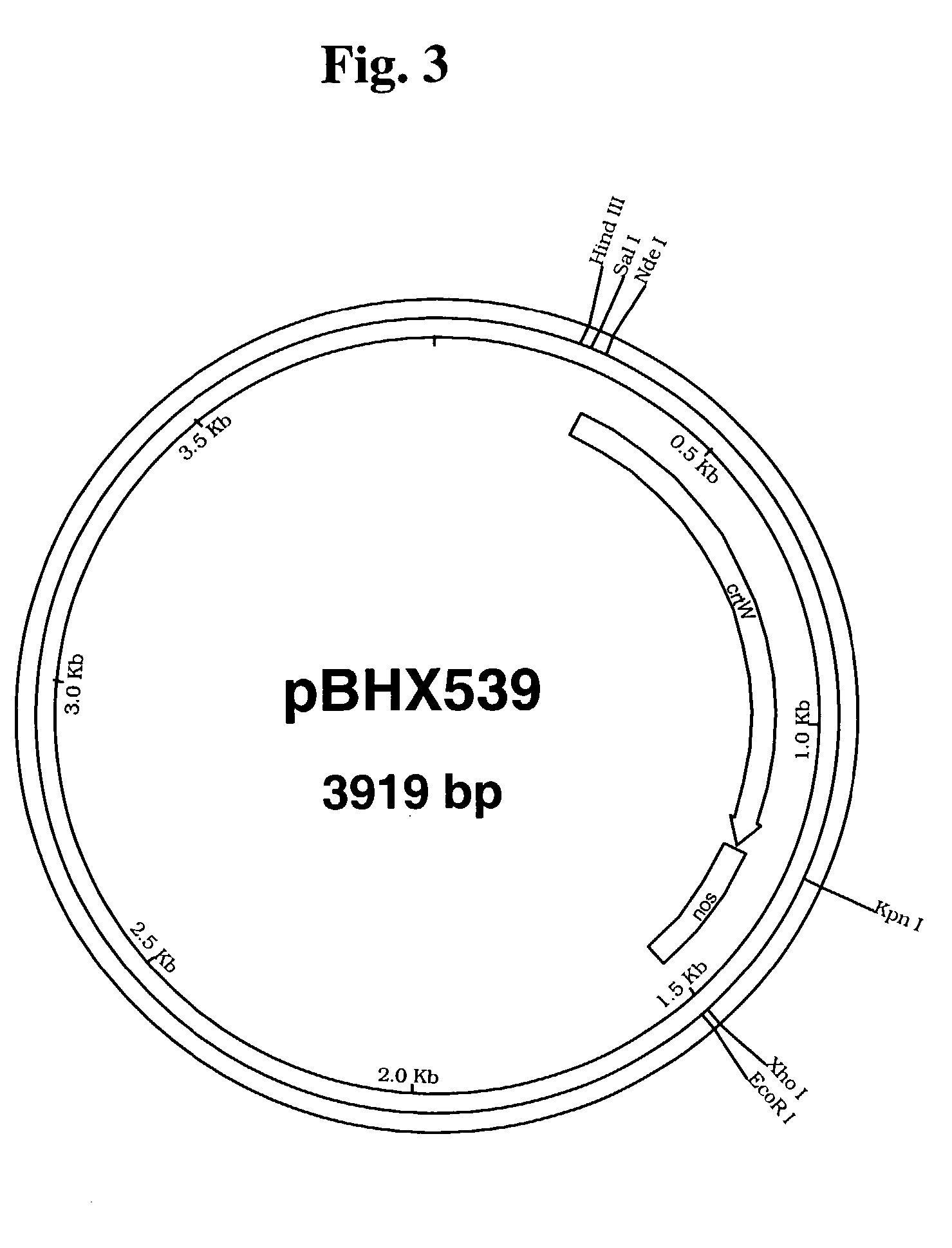4-ketocarotenoids in flower petals
a technology of ketocarotenoids and flower petals, applied in the direction of biocide, plant/algae/fungi/lichens, animal repellents, etc., can solve the problems of inability to accept by-products, high labor intensity, and inability to isolate astaxanthin from contaminants,
- Summary
- Abstract
- Description
- Claims
- Application Information
AI Technical Summary
Benefits of technology
Problems solved by technology
Method used
Image
Examples
example 1
Construction of β-Carotene Ketolase (β-Carotene Oxygenase) Expression Vectors
[0235]A. β-Carotene Ketolase from H. pluvialis
[0236]The β-carotene ketolase gene (crtw) from Haematococcus pluvialis [See Kajiwara et al., Plant Mol Biol., 29(2):343–352 (1995)] was prepared by polymerase chain reaction (PCR) using as template a clone of the gene obtained from Dr. Toshihiro Toguri, Kirin Brewery Co., Ltd. The specific primers that were used introduced a Kpn I restriction site at the 3′ end of the gene (crtW-L28: GCCAGTGCCAAGGTACCTCTGTCATGCC; SEQ ID NO: 1) and a Nde I site at the 5′ end (crtW-U28: CCGGGGATCCTCTACATATGCACGTCGC; SEQ ID NO: 2). After digestion with Kpn I and Nde I, the crtW gene was ligated into the plasmid pBHX533 (FIG. 2) containing the nopaline synthase poly-adenylation signal. The resulting vector was designated pBHX539 (FIG. 3).
[0237]The transit peptide from the Nicotiana tabacum ribulose bisphosphate carboxylase small subunit (RUBISCO; rbcs) [See Mazur et al., Nucleic Ac...
example 2
Binary Vectors
Plasmid pBHX103
[0250]A plasmid containing the 5′-flanking region of the Clarkia breweri LIS1 gene was obtained from Dr. Eran Pichersky of the University of Michigan. An about 1 kb fragment containing the LIS1 5′-flanking region was synthesized by PCR using the primers: BHX30: CCAAGCTTATCTAATAATGTATCAAAATC (SEQ ID NO: 11) and BHX36: CAGCCCGGGATGGTTGTCTTGTTTAAGGTGG (SEQ ID NO: 12). These primers were designed to anneal to the 5′ flanking region at one end and within the 5′ untranslated leader region at the 3′ end. The PCR product was digested with the restriction enzymes, Hind III and Sma I, which cleave at the 5′ and 3′ ends of the fragment, respectively. The digested fragment was gel-purified and subsequently inserted into a Hind III- and Sma I-digested plasmid containing a multi-cloning site region (MCS) followed by the nos polyA signal-containing region to create a LIS1::MCS::nos transgene (designated plasmid pBHX103).
Plasmid pBHX107
[0251]A 1.5 kb Hinc II fragment fr...
example 3
EMS Treatment of Tagetes erecta ‘Scarletade’
[0279]Seeds of Tagetes erecta xanthophyll marigold denominated ‘Scarletade’ (commercially available from PanAmerican Seed Co. 622 Town Road, West Chicago, Ill. 60185) were treated with ethyl methanesulfonate (EMS, commercially available from Sigma Chemical Co., St. Louis, Mo. 63178). Approximately 2,500 seeds were added to 400 ml of 0.4% (v / v) or 0.8% (v / v) EMS and were stirred gently for eight hours at ambient temperature. During a four-hour period following the EMS treatment, the seeds were washed sixteen times, each wash using continuous stirring with 400 ml distilled water. The treated seeds, identified as M1 seeds, were then sown in trays containing soilless potting mix.
[0280]After several weeks, the seedlings were transplanted into pots(containing soilless potting mix and maintained in the greenhouse. Flowers produced by those plants were naturally self-pollinated. The resulting seeds, identified as M2 seeds, were harvested from appr...
PUM
| Property | Measurement | Unit |
|---|---|---|
| temperature | aaaaa | aaaaa |
| temperature | aaaaa | aaaaa |
| temperature | aaaaa | aaaaa |
Abstract
Description
Claims
Application Information
 Login to View More
Login to View More - R&D
- Intellectual Property
- Life Sciences
- Materials
- Tech Scout
- Unparalleled Data Quality
- Higher Quality Content
- 60% Fewer Hallucinations
Browse by: Latest US Patents, China's latest patents, Technical Efficacy Thesaurus, Application Domain, Technology Topic, Popular Technical Reports.
© 2025 PatSnap. All rights reserved.Legal|Privacy policy|Modern Slavery Act Transparency Statement|Sitemap|About US| Contact US: help@patsnap.com



